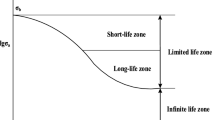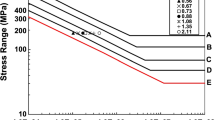Abstract
Since the accurate prediction of fatigue life has a significant value, many researchers have attempted to develop a reliable fatigue life model. Recently, rolling contact fatigue life models incorporating machining impact were developed. These models have contributed to a significant improvement in prediction accuracy as compared with earlier models, thus representing a major step forward in the modeling effort. This paper compares the prediction accuracy of these models with that of the prediction method in International Standards. When α is set to 0.25, the observed improvement of prediction accuracy as measured by variance of prediction errors due to these models over that due to prediction method in International Standards is statistically significant. Impact analyses of such improvement are conducted to illustrate its value. It is further noted that while difference was observed between the variance of prediction errors due to the crack initiation life model based on a dislocation model and that due to the crack initiation life model based on a local stress-life curve, the observed difference is not statistically significant.
Similar content being viewed by others
References
X. Yang, A methodology for predicting the variance life incorporating the effects of manufacturing processes, Ph.D. Thesis, Purdue University (2001).
S. Cho and W. Joo, A study on fatigue crack growth and life modeling using backpropagation neural networks, Transactions of the Korean Society of Mechanical Engineers A, 24 (2000) 634–644.
D. W. Lee and S. H. Hong, A study on fatigue damage modeling using neural networks, Journal of Mechanical Science and Technology, 19 (2005) 1393–1404.
X. Yang and C. R. Liu, A methodology for predicting the variance of fatigue life incorporating the effects of manufacturing processes, Journal of Manufacturing Science and Engineering, 124 (2002) 745–753.
X. Yang, C. R. Liu and A. F. Grandt, An experimental study on fatigue life variance, residual stress variance, and their correlation of face-turned and ground TI 6AL-4V samples, Journal of Manufacturing Science and Engineering, 124 (2002) 809–819.
Y. Choi and C. R. Liu, Rolling contact fatigue life of finish hard machined surfaces: Part 1. Model development, Wear, 261 (2006) 485–491.
Y. Choi and C. R. Liu, Rolling contact fatigue life of finish hard machined surfaces: Part 2. Experimental verification, Wear, 261 (2006) 492–499.
Y. Choi and C. R. Liu, A new methodology for predicting crack initiation life for rolling contact fatigue based on dislocation and crack propagation, International Journal of Mechanical Sciences, 50 (2008) 117–123.
G. Lundberg and A. Palmgren, Dynamic capacity of rolling bearings, Acta Polytechnica Mechanical Engineering Series, 1 (1947) 3.
G. Lundberg and A. Palmgren, Dynamic capacity of rolling bearings, Acta Polytechnica Mechanical Engineering Series, 2 (1952) 4.
International standards organization, Rolling bearingsdynamic load ratings and rating life: Part 1. Calculation methods, International Standard, 281/1-1977 (E).
O. H. Basquin, The experimental law of endurance tests, ASTM, 10 (1910) 625–630.
R. I. Stephens, A. Fatemi, R. R. Stephens and H. O. Fuchs, Metal fatigue in engineering, Wiley-Interscience, New York, USA (2001).
X. Leng, Q. Chen and E. Shao, Initiation and propagation of case crushing cracks in rolling contact fatigue, Wear, 122 (1988) 33–43.
E. Bormetti, G. Donzella and A. Mazzu, Surface and subsurface cracks in rolling contact fatigue of hardened components, Tribology Transactions, 45 (2002) 274–283.
P. Paris and F. Erdogan, A critical analysis of crack propagation laws, Journal of Basic Engineering (1963) 528–534.
Q. Chen, X. Leng and E. Shao, Influence of microstructure and residual stress on the stages of case crushing, Wear, 122 (1988) 45–55.
A. D. Hearle and K. L. Johnson, Mode II stress intensity factors for a crack parallel to the surface of an elastic halfspace subjected to a moving point load, Journal of Mechanics and Physics of Solids, 33 (1985) 61–81.
B. Jiang, X. Zheng and M. Wang, Calculation for rolling contact fatigue life and strength of case-hardened gear materials by computer, Journal of Testing and Evaluation, 21 (1993) 9–13.
B. L. Averbach, Fracture of bearing steels, Metal Progress, December (1980).
S. R. Agha, Fatigue performance of superfinish hard turned surfaces in rolling contact, Ph.D. Thesis, Purdue University (2000).
K. Tanaka and T. Mura, Dislocation model for fatigue crack initiation, Journal of Applied Mechanics, 48 (1981) 97–103.
R. S. Zhou, H. S. Cheng and T. Mura, Micropitting in rolling and sliding contact under mixed lubrication, Journal of Tribology, 111 (1989) 605–613.
C. Kaynak, A. Ankara and T. J. Baker, Initiation and early growth of short fatigue cracks at inclusions, Materials Science and Technology, 12 (1996) 421–426.
A. Melander, A finite element study of short cracks with different inclusion types under rolling contact fatigue load, International Journal of Fatigue, 19 (1997) 13–24.
D. Nelias, M. L. Dumont, F. Champiot, A. Vincent, D. Girodin, R. Fougeres and L. Flamand, Role of inclusions, surface roughness and operating conditions on rolling contact fatigue, Journal of Tribology, 121 (1999) 240–251.
E. Bormetti, G. Donzella and A. Mazzu, Surface and subsurface cracks in rolling contact fatigue of hardened components, Tribology Transactions, 45 (2002) 274–283.
T. A. Harris, Rolling bearing analysis, Wiley-Interscience, New York, USA (2001).
Q. Y. Wang, C. Bathias, N. Kawagoishi and Q. Chen, Effect of inclusion on subsurface crack initiation and gigacycle fatigue strength, International Journal of Fatigue, 24 (2002) 1269–1274.
S. R. Agha and C. R. Liu, Experimental study on the performance of superfinish hard turned surfaces in rolling contact, Wear, 244 (2000) 52–59.
G. Taguchi, Taguchi on robust technology development: Bringing quality engineering upstream, ASME press (1993).
G. Bellows, Low stress grinding for quality production, Machinability Data Center (1978).
Author information
Authors and Affiliations
Corresponding author
Additional information
Recommended by Associate Editor Youngseog Lee
Youngsik Choi is an Assistant Professor of Mechanical Engineering at Chung-Ang University in Seoul, South Korea. He received his Ph.D. degree in industrial engineering from Purdue University. His research interests are in the area of design and manufacturing.
Rights and permissions
About this article
Cite this article
Choi, Y., Yang, X. Impact evaluation of rolling contact fatigue life models. J Mech Sci Technol 26, 1865–1873 (2012). https://doi.org/10.1007/s12206-012-0431-6
Received:
Revised:
Accepted:
Published:
Issue Date:
DOI: https://doi.org/10.1007/s12206-012-0431-6




